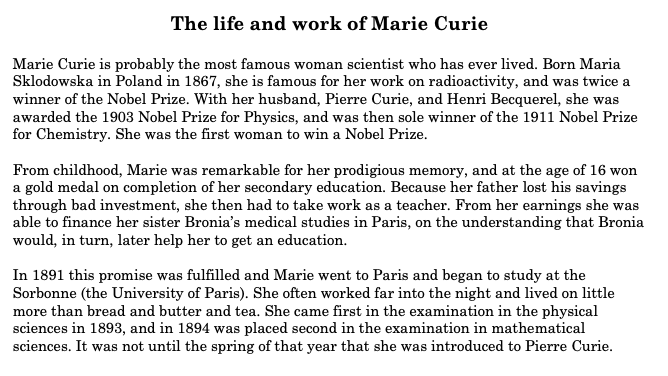
Explanation:
"Marie Curie’s husband was a joint winner of both Marie’s Nobel Prizes" is False. While Pierre Curie shared the Nobel Prize in Physics with Marie Curie and Henri Becquerel in 1903, he was not a joint winner of Marie's Nobel Prize in Chemistry in 1911.
Explanation:
The passage does not explicitly state whether Marie became interested in science when she was a child or not.
Explanation:
The passage mentions that Marie was able to attend the Sorbonne (the University of Paris) and begin her studies there because of her sister Bronia's financial support. It states, "From her earnings, she was able to finance her sister Bronia’s medical studies in Paris, on the understanding that Bronia would, in turn, later help her to get an education." Therefore, it can be inferred that Marie was able to attend the Sorbonne due to her sister's financial contribution.
Explanation:
The passage describes how theoretical physicists applied concepts from the study of gas molecules to understand traffic flow behavior.
Explanation:
The passage discusses a proposal to potentially regulate traffic flow by directly controlling the speed and spacing of individual cars using central computers and sensors. This proposal suggests implementing a system where vehicles' entry onto a highway is timed precisely to coincide with fluctuations in road conditions, aiming to prevent congestion. The idea entails taking control away from individual drivers and relying on centralized control systems to manage traffic flow.
Explanation:
The passage describes the skepticism and disagreement among experts, particularly civil engineers, regarding the application of theoretical physics concepts to traffic control. Civil engineers, who typically focus on practical approaches to traffic problems, question the relevance of the physicists' theories to real-world traffic situations. They argue that traffic congestion is primarily caused by factors such as poor road construction, rather than the complex theories proposed by physicists. This disagreement highlights the differing perspectives and areas of doubt between experts in the field.
Explanation:
The passage discusses how driver psychology and behavior contribute to traffic dynamics. Specifically, it suggests that sudden slowdowns in traffic may be influenced more by driver actions, such as aggressive lane-changing and braking behaviors, rather than complex chaos theory principles. This highlights the significant impact of driver behavior on traffic flow and speed.
Advertisement
Please select 2 correct answers
Explanation:
The passage highlights two advantages of older workers: their ability to predict areas that may cause trouble in the future and their greater skill in personal relationships. This suggests that older workers possess valuable experience and interpersonal skills that can contribute to effective management and problem-solving in the workplace.
Please select 2 correct answers
Explanation:
The passage discusses two disadvantages of younger workers. Firstly, they may injure themselves due to their lack of experience or caution. Secondly, they are not as well educated as older workers, which suggests that older workers may possess more knowledge or experience in their respective fields.
Explanation:
Skill Team, as described in the passage, is a separate company set up by IBM Belgium to re-employ early retired workers between the ages of 55 and 60. The purpose of Skill Team was to allow these older workers to continue working and to retain access to their intellectual capital. Therefore, Skill Team allows the expertise of older workers to be put to use.
Explanation:
The passage mentions that there are two distinct types of bridge job-holders: those who continue working because they have to and those who continue working because they want to, even though they can afford to retire. This suggests that bridge jobs appeal to distinct groups of older workers with different motivations for continuing to work.